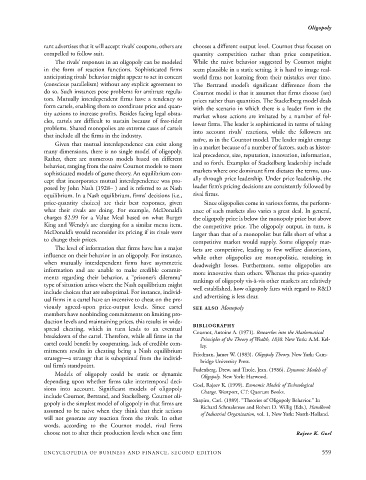Page 582 - Encyclopedia of Business and Finance
P. 582
eobf_O 7/5/06 3:17 PM Page 559
Oligopoly
rant advertises that it will accept rivals’ coupons, others are chooses a different output level. Cournot thus focuses on
compelled to follow suit. quantity competition rather than price competition.
The rivals’ responses in an oligopoly can be modeled While the naive behavior suggested by Cournot might
in the form of reaction functions. Sophisticated firms seem plausible in a static setting, it is hard to image real-
anticipating rivals’ behavior might appear to act in concert world firms not learning from their mistakes over time.
(conscious parallelism) without any explicit agreement to The Bertrand model’s significant difference from the
do so. Such instances pose problems for antitrust regula- Cournot model is that it assumes that firms choose (set)
tors. Mutually interdependent firms have a tendency to prices rather than quantities. The Stackelberg model deals
form cartels, enabling them to coordinate price and quan-
with the scenario in which there is a leader firm in the
tity actions to increase profits. Besides facing legal obsta-
market whose actions are imitated by a number of fol-
cles, cartels are difficult to sustain because of free-rider lower firms. The leader is sophisticated in terms of taking
problems. Shared monopolies are extreme cases of cartels into account rivals’ reactions, while the followers are
that include all the firms in the industry.
naïve, as in the Cournot model. The leader might emerge
Given that mutual interdependence can exist along
in a market because of a number of factors, such as histor-
many dimensions, there is no single model of oligopoly.
ical precedence, size, reputation, innovation, information,
Rather, there are numerous models based on different
and so forth. Examples of Stackelberg leadership include
behavior, ranging from the naive Cournot models to more
sophisticated models of game theory. An equilibrium con- markets where one dominant firm dictates the terms, usu-
cept that incorporates mutual interdependence was pro- ally through price leadership. Under price leadership, the
posed by John Nash (1928– ) and is referred to as Nash leader firm’s pricing decisions are consistently followed by
equilibrium. In a Nash equilibrium, firms’ decisions (i.e., rival firms.
price-quantity choices) are their best responses, given Since oligopolies come in various forms, the perform-
what their rivals are doing. For example, McDonald’s ance of such markets also varies a great deal. In general,
charges $2.99 for a Value Meal based on what Burger the oligopoly price is below the monopoly price but above
King and Wendy’s are charging for a similar menu item. the competitive price. The oligopoly output, in turn, is
McDonald’s would reconsider its pricing if its rivals were larger than that of a monopolist but falls short of what a
to change their prices.
competitive market would supply. Some oligopoly mar-
The level of information that firms have has a major kets are competitive, leading to few welfare distortions,
influence on their behavior in an oligopoly. For instance, while other oligopolies are monopolistic, resulting in
when mutually interdependent firms have asymmetric deadweight losses. Furthermore, some oligopolies are
information and are unable to make credible commit- more innovative than others. Whereas the price-quantity
ments regarding their behavior, a “prisoner’s dilemma”
rankings of oligopoly vis-à-vis other markets are relatively
type of situation arises where the Nash equilibrium might
well established, how oligopoly fares with regard to R&D
include choices that are suboptimal. For instance, individ-
and advertising is less clear.
ual firms in a cartel have an incentive to cheat on the pre-
viously agreed-upon price-output levels. Since cartel SEE ALSO Monopoly
members have nonbinding commitments on limiting pro-
duction levels and maintaining prices, this results in wide-
spread cheating, which in turn leads to an eventual BIBLIOGRAPHY
Cournot, Antoine A. (1971). Researches into the Mathematical
breakdown of the cartel. Therefore, while all firms in the Principles of the Theory of Wealth, 1838. New York: A.M. Kel-
cartel could benefit by cooperating, lack of credible com-
ley.
mitments results in cheating being a Nash equilibrium
Friedman, James W. (1983). Oligopoly Theory. New York: Cam-
strategy—a strategy that is suboptimal from the individ-
bridge University Press.
ual firm’s standpoint.
Fudenberg, Drew, and Tirole, Jean. (1986). Dynamic Models of
Models of oligopoly could be static or dynamic
Oligopoly. New York: Harwood.
depending upon whether firms take intertemporal deci-
Goel, Rajeev K. (1999). Economic Models of Technological
sions into account. Significant models of oligopoly Change. Westport, CT: Quorum Books.
include Cournot, Bertrand, and Stackelberg. Cournot oli-
gopoly is the simplest model of oligopoly in that firms are Shapiro, Carl. (1989). “Theories of Oligopoly Behavior.” In
Richard Schmalensee and Robert D. Willig (Eds.), Handbook
assumed to be naive when they think that their actions
of Industrial Organization, vol. 1, New York: North-Holland.
will not generate any reaction from the rivals. In other
words, according to the Cournot model, rival firms
choose not to alter their production levels when one firm Rajeev K. Goel
ENCYCLOPEDIA OF BUSINESS AND FINANCE, SECOND EDITION 559

